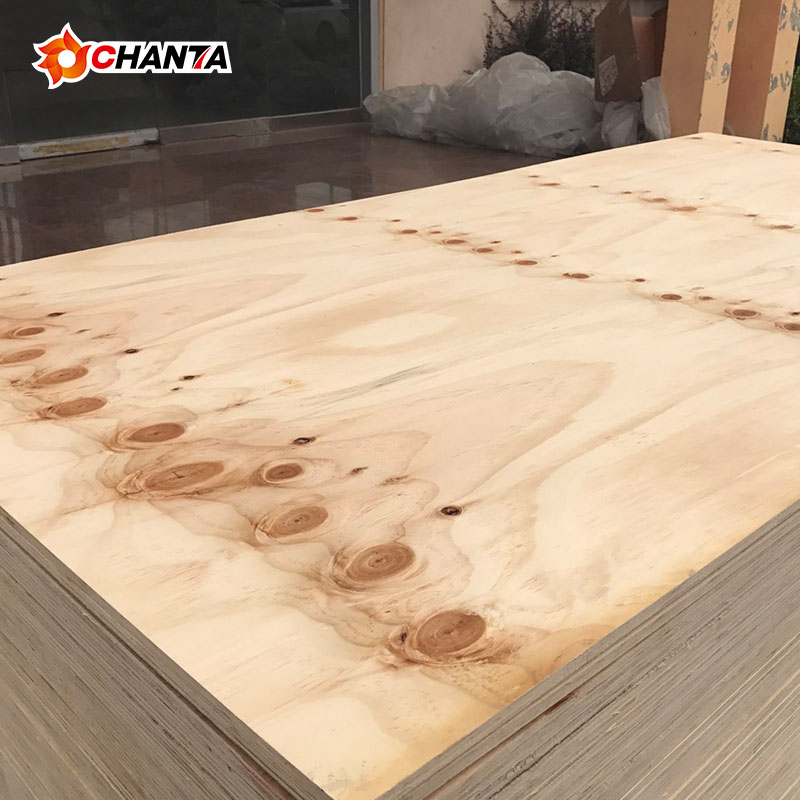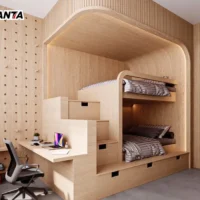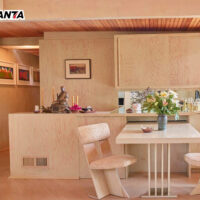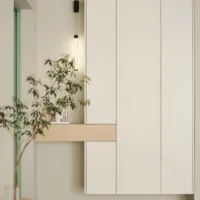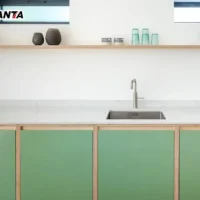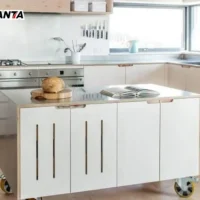Melamine board is popular in furniture and cabinetry due to its affordability and smooth finish, making it a practical choice for many indoor applications. However, if you’re considering using melamine outdoors, it’s essential to understand its properties and limitations in outdoor environments.
What Is Melamine?
Melamine is a composite material created by fusing melamine resin with a core of particleboard or MDF (Medium Density Fiberboard). The result is a sturdy, smooth-surfaced board that’s resistant to scratches and stains. The outer melamine layer comes in various colors and patterns, allowing it to mimic wood or other finishes. Melamine is frequently used indoors for furniture, shelving, and cabinetry, where its durable coating provides a polished look and functional surface.
Melamine’s Resistance to Outdoor Elements
When considering melamine for outdoor use, durability in variable weather is a critical factor. Melamine’s core, typically made from particleboard or MDF, is highly susceptible to moisture. If exposed to rain or humidity, this core material can swell, warp, and weaken over time. Even though melamine has a water-resistant coating, it does not make the board waterproof. Once moisture penetrates this coating, the underlying core is prone to damage.
Melamine also doesn’t handle UV exposure well. Direct sunlight can cause fading, discoloration, and eventual deterioration of the melamine surface. Unlike outdoor-specific materials such as treated wood or certain plastics, melamine is not designed to withstand long-term exposure to sunlight or changing weather conditions.
Why Melamine Is Best for Indoor Use
Given its vulnerability to moisture and UV rays, melamine is best suited for indoor environments. The following are some of the benefits it offers indoors:
- Scratch and Stain Resistance: Melamine’s outer layer is designed to resist everyday wear and tear, making it ideal for cabinets, shelves, and furniture.
- Affordability: Melamine is often more cost-effective than other materials like plywood, making it a budget-friendly option for indoor projects.
- Variety of Styles: Melamine is available in numerous colors and patterns, allowing you to match it with various interior designs.
These qualities make melamine highly effective for indoor applications but limited when used outdoors.
Alternatives to Melamine for Outdoor Use
If you need a material for outdoor projects, consider options that offer weather resistance and durability. Here are some reliable alternatives:
- Pressure-Treated Wood: Treated wood is processed to resist moisture, insects, and decay, making it a strong option for outdoor furniture or decking. It maintains structural integrity in outdoor conditions.
- Marine-Grade Plywood: This plywood is specifically treated to withstand moisture and resist rot, making it ideal for outdoor furniture and structures. Although more expensive, it provides long-lasting performance in various weather conditions.
- Plastic or Resin Materials: Durable and waterproof, plastics and resins are often used for outdoor furniture. They’re resistant to moisture, UV exposure, and general wear, making them well-suited to outdoor environments.
- Composite Wood: A blend of wood fibers and plastic, composite wood resists moisture and requires minimal maintenance, making it a good choice for decks, fences, and outdoor furniture.
These materials offer the strength and resilience that melamine lacks outdoors, making them better choices for withstanding outdoor elements.
Can Melamine Be Used Outdoors Temporarily?
While melamine is not designed for extended outdoor exposure, it can be used temporarily outdoors, provided it is protected from rain and direct sunlight. For example, melamine furniture or shelving can be used on a covered patio or in an enclosed outdoor space where it’s shielded from the elements. However, it’s important to remember that even in a covered area, changes in temperature and humidity can affect melamine’s longevity.
If you choose to use melamine outdoors temporarily, consider adding a protective sealant to reduce its exposure to moisture. However, even with a sealant, melamine may still experience wear over time, as sealants can only provide limited protection.
Final Verdict: Is Melamine Good for Outdoor Use?
In summary, melamine is not suitable for outdoor use due to its sensitivity to moisture and UV rays. Its particleboard or MDF core can warp or swell when exposed to moisture, and its surface may fade in sunlight. While it performs well indoors, especially in cabinetry and furniture, it is not designed for outdoor conditions.
If you’re planning an outdoor project, consider alternative materials that offer greater resistance to moisture, sunlight, and temperature changes. With the right material, you can ensure a lasting, durable, and beautiful finish that will withstand the outdoors.














